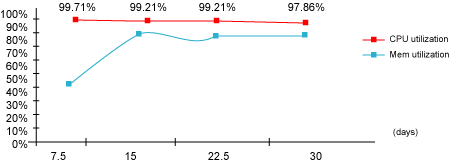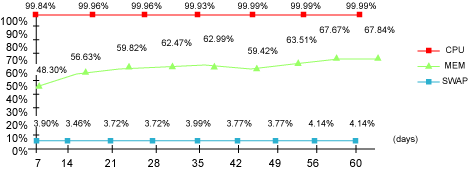
Putting Linux reliability to the test
The Linux Technology Center evaluates the long-term reliability of Linux
Li Ge, Staff Software Engineer, Linux Technology Center, IBM
Linda Scott, Senior Software Engineer, Linux Technology Center, IBM
Mark VanderWiele, Senior Technical Staff Member, Linux Technology Center, IBM
17 Dec 2003
This article documents the test results and analysis of the Linux kernel and other core OS components, including everything from libraries and device drivers to file systems and networking, all under some fairly adverse conditions, and over lengthy durations. The IBM Linux Technology Center has just finished this comprehensive testing over a period of more than three months and shares the results of their LTP (Linux Test Project) testing with developerWorks readers.
The IBM Linux Technology Center (LTC) was founded in August 1999 to work directly with the Linux development community with a shared vision of making Linux succeed. Its 200-odd employees make it one of the larger corporate groups of open source developers. They contribute code ranging from patches to structural kernel changes; from file systems and internationalization work to GPL'd drivers. They also work to track Linux-related developments within IBM.
Particular areas of interest for the LTC are Linux scalability, serviceability, reliability, and systems management -- all with a view to making Linux ever more enterprise-ready. Enabling Linux to work on the S/390 mainframe and porting the JFS journaling file system to Linux are among their many contributions to the community.
Another of the LTC's core missions is to professionally test Linux in lab settings the way any commercial project is tested. The LTC contributes to the LTP Linux Test Project (LTP), as do SGI, OSDL, Bull, and Wipro Technologies. What follows are the results obtained from a comprehensive set of tests from the LTP suite on the Linux kernel for an extended period of time. As you may have guessed, Linux held up admirably under the continued stress.
Linux reliability measurement
Objectives
The objective of the Linux reliability effort at the IBM Linux Technology Center is to measure the Linux operating system's stability and reliability over long periods of time with an emphasis on workloads relevant to Linux customer environments using the LTP test suite (see Resources for more on the LTP). Identification of defects was not the primary focus.
Test environment overview
This article describes the test results and analysis of 30- and 60-day Linux reliability measure tests using the LTP test suite. The tests used SuSE Linux Enterprise Server v8 (SLES 8) as the testing kernel and IBM pSeries servers as testing hardware. A specially designed stress-test scenario of LTP was used to exercise a wide range of kernel components in parallel with networking and memory management, and to create a high stress workload on the testing system. The Linux kernel, TCP, NFS, and I/O test components were targeted with a heavy-stress workload.
The tests
At 30 days
30-day LTP stress execution results for pSeries
Observations:
Figure 1. 30-day LTP stress execution results

At 60 days
60-day LTP stress execution results: pSeries
Observations:
Figure 2. 60-day LTP stress execution results

Test infrastructure
Hardware and software environment
Table 1 shows the hardware environment.
Table 1. Hardware environment
| System | Processors | Memory | Disk | Swap partition | Network |
| pSeries 650 (LPAR) Model 7038-6M2 | 2 - POWER4+(TM) 1.2GHz | 8GB (8196MB) | 36GB U320 IBM Ultrastar (other disks present, but unused) | 1GB | Ethernet controller: AMD PCnet32 |
| pSeries 630 Model 7026-B80 | 2 - POWER3(TM)+ 375 MHz | 8GB (7906MB) | 16GB | 1GB | Ethernet controller: AMD PCnet32 |
The software environment was the same for both the pSeries 630 Model 7026-B80 and the pSeries 650 (LPAR) Model 7038-6M2. Table 2 shows the software environment.
Table 2. Software environment
| Component | Version |
| Linux | SuSE SLES 8 with Service Pack 1 |
| Kernel | 2.4.19-ul1-ppc64-SMP |
| LTP | 20030514 |
Methodology
System stability and reliability are generally measured as continuous hours of operation and reliable uptime of a system.
The runs started with a set of 30-day baseline runs and progressed to 60- and 90-day Linux test runs on xSeries and pSeries servers. Initial emphasis was placed on kernel, networking, and I/O testing.
Test tool
The Linux Test Project (LTP; see Resources for links and more information) is a joint project with SGI, IBM, OSDL, Bull, and Wipro Technologies with a goal to deliver test suites to the open source community that test the reliability, robustness, and stability of Linux. The Linux Test Project is a collection of tools for testing the Linux kernel and related features. The goal is to help improve the Linux kernel by bringing test automation to the kernel testing effort.
Currently, there are over 2000 test cases within the LTP suite, covering the majority of kernel interfaces such as syscalls, memory, IPC, I/O, filesystems, and networking. The test suite is updated and released monthly and runs on multiple architectures. There are 11 known LTP test suite tested architectures including i386, ia64, PowerPC, PowerPC 64, S/390, S/390x (64bit), MIPS, mipsel, cris, AMD Opteron, and embedded architectures. We used LTP version 20030514 -- the latest available at the time -- in our reliability testing.
Test strategy
There were two unique phases in the baseline run: a 24-hour "initial test," followed by the stress reliability run phase, or "stress test."
Passing the initial test was an entry requirement. The initial test consisted of a successful 24-hour run of the LTP test suite on the hardware and operating system that would be used for reliability runs. The driver script runalltests.sh, which comes with the LTP test suite package, was used to validate the kernel. This script runs a group of packaged tests in sequential order and reports the overall result. It also has the option to launch several instances running in parallel simultaneously. By default, this script executes:
The stress test verified the robustness of the product during high system usage. In addition to runalltests.sh, a test scenario called ltpstress.sh was specially designed to exercise a wide range of kernel components in parallel with networking and memory management and to create a high-stress workload on the testing system. ltpstress.sh is also part of the LTP test suite. The script runs similar test cases in parallel and different test cases in sequence in order to avoid intermittent failures caused by running into the same resources or interfering with one another. By default, this script executes:
System monitoring
The modified top utility that comes with the LTP test suite was
used as a system monitoring tool. top provides an ongoing look at processor
activity in real time. The enhanced top utility has additional functions
that can save snapshots of top results to a file and give the average
summary of the resulting file, including information such as CPU, memory, and swap
space utilizations.
In our tests, snapshots of system utilization (or top output files)
were taken every 10 seconds and saved to result files. In addition, snapshots of
system utilization and LTP test output files were taken daily or weekly to have
data points to determine whether systems were degrading during long-period runs.
This function was controlled by cron jobs and scripts.
Before testing
All selected testing systems had hardware configured as similarly to each other
as possible. Extra hardware was removed to reduce potential hardware failure. Minimum-security
options were selected during image installation. At least 2 GB of disk space was
reserved for storing the top data files and LTP log files.
Note that this is a testing scenario; in real life, users would be well advised to keep security settings at much higher than minimum.
During testing
The system was left undisturbed for the duration of the tests. Occasional access
of the system to verify that the test was still executing was acceptable. Verification
included using the ps command, checking top data, and
checking LTP log data.
After testing
When the test completed, the system monitoring tool top was stopped
immediately. All top data files, including daily or weekly snapshots
and LTP log files, were saved and processed in order to provide data for analysis.
Conclusions
The findings discussed in this article are based on a solution that was created and tested under laboratory conditions. These findings may not be realized in all environments, and implementation in such environments may require additional steps, configurations, and performance analysis.
However, as most Linux kernel testing efforts have only been conducted over short periods of time, this series of tests provides us first-hand data and results of longer runs. The series of tests also provides data for heavy-stress workloads on Linux kernel components, as well as TCP, NFS, and other test components. The tests demonstrate that the Linux system is reliable and stable over long durations and can provide a robust, enterprise-level environment.
Resources
About the authors
Li Ge is a Staff Software Engineer in the IBM Linux Technology Center. She graduated from New Mexico State University with an MS in Computer Science in 2001. She has been working on Linux for three years and is currently working on Linux kernel validation and Linux reliability measurement. She can be reached at mailto: lge@us.ibm.com
Linda Scott is a Senior Software Engineer and has worked at IBM development labs in the state of Texas since graduating from Jackson State University. During her career with IBM, Linda has worked on a variety of Unix and Linux projects and is currently working on the Linux Test Project where over 2000 test cases have been delivered to the open source community. She can be reached at lindajs@us.ibm.com
Mark VanderWiele is a Senior Technical Staff Member and Architect in the IBM Linux Technology Center. He graduated from Florida State University in 1983 and has spent the majority of his career in various aspects of operating system development. He can be reached at markv@us.ibm.com
Copyright 2003